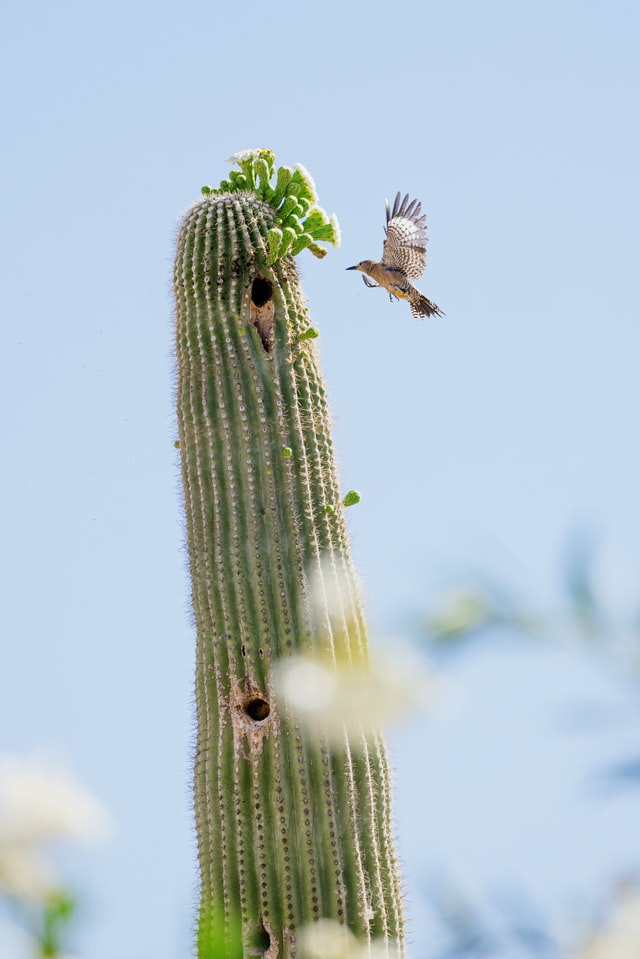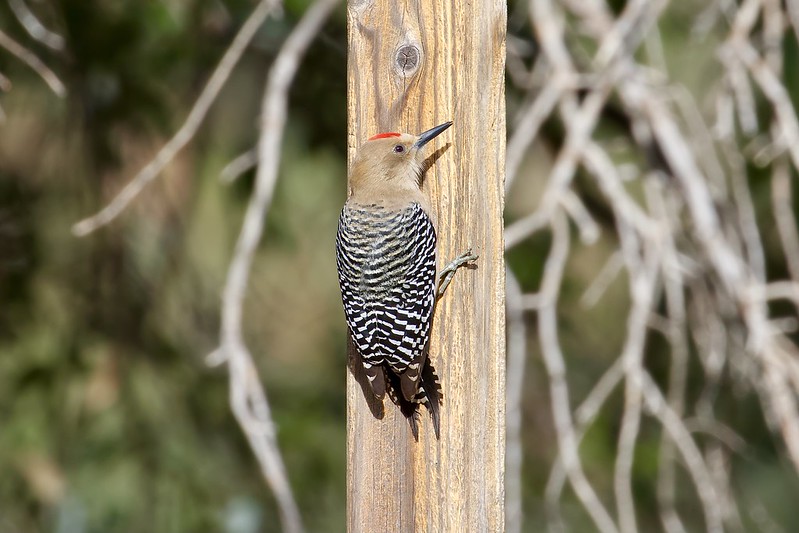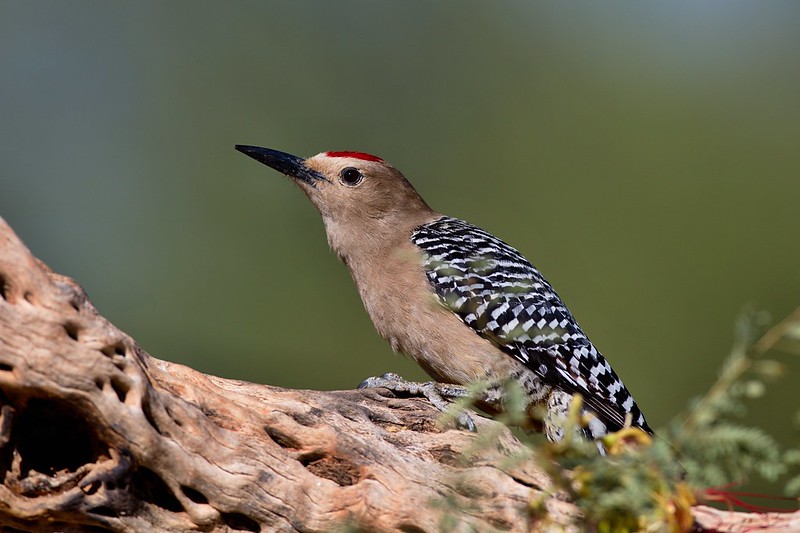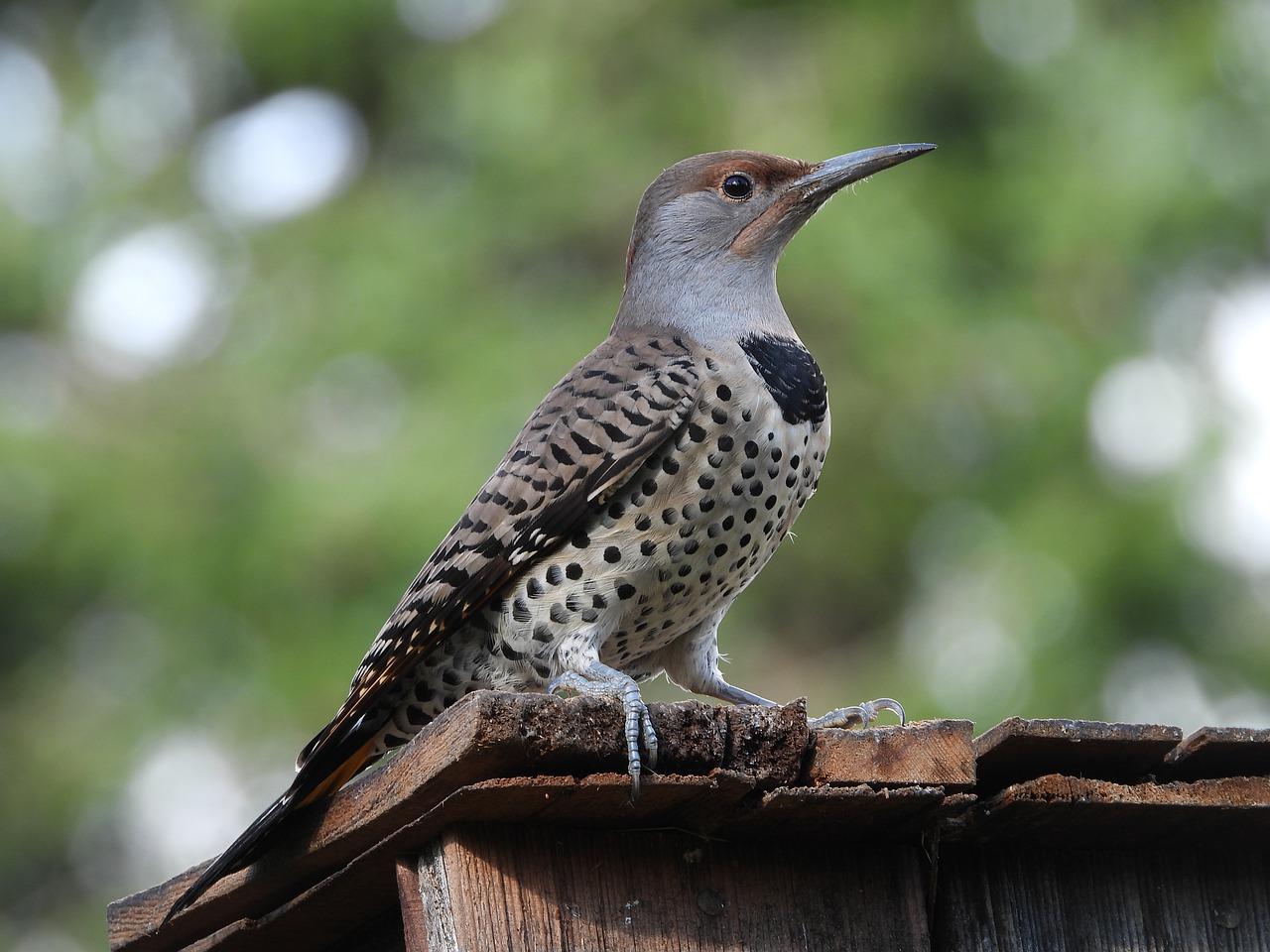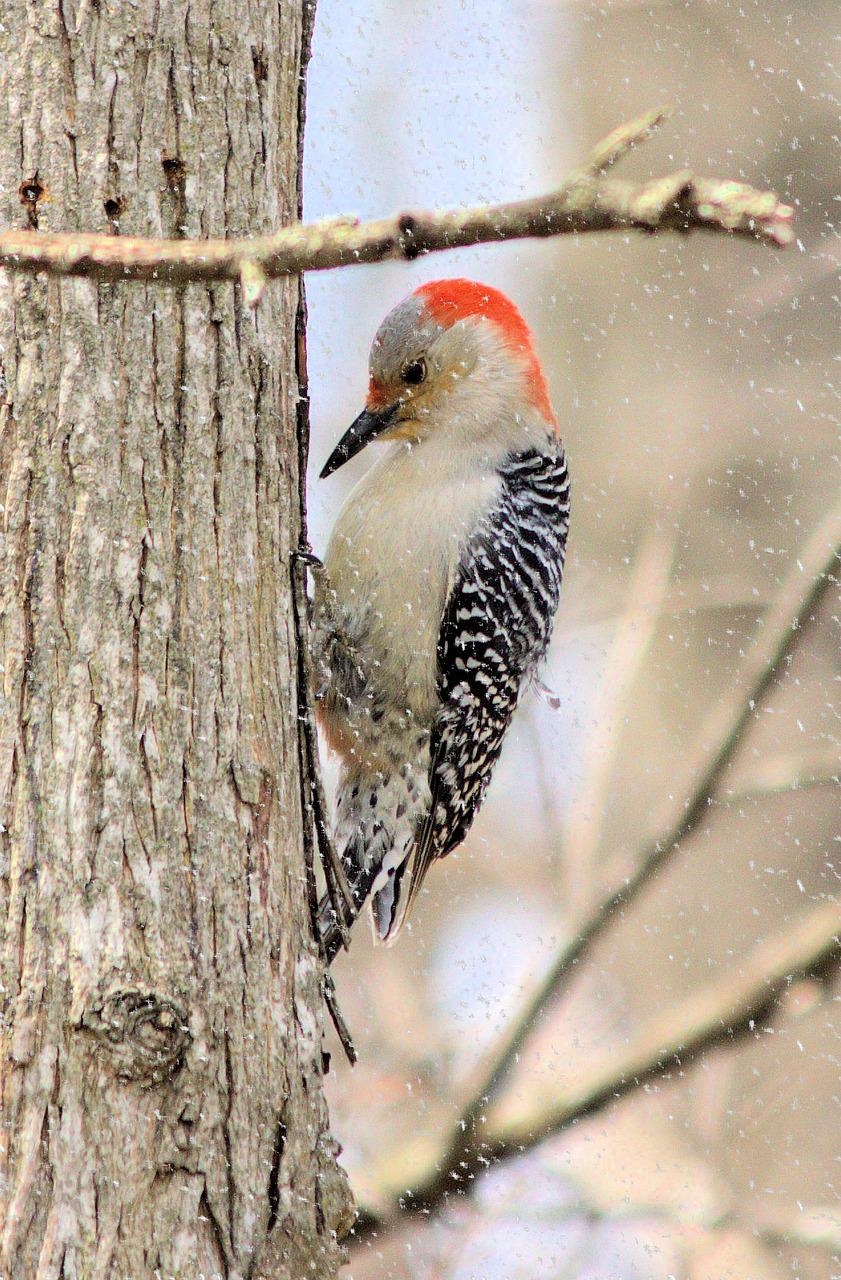- Gila Woodpecker Guide (Melanerpes uropygialis) - July 5, 2022
The first time I saw a Gila Woodpecker, I was doing the dishes at my kitchen sink. Looking out my window, I suddenly saw this small-but-mighty bird hopping up the trunk of a palm tree.
I didn’t know what it was at first. But then it started jabbing the trunk with its beak, bits of bark flying like electrical sparks. I knew it was a woodpecker, but which one? I quickly opened the Audubon app and soon discovered I was seeing the one and only Gila Woodpecker.
Although perhaps not the first bird people think of when they hear “woodpecker,” Gila Woodpeckers are abundant in central and southern Arizona, southeastern California, Baja California, and the Gulf of California.
Ever since I identified the Gila Woodpecker outside my window, I found them on morning hikes and evening walks throughout Phoenix. They are abundant, cute, feisty, and fascinating – the perfect kind of bird to have around your backyard!
Taxonomy
Gila (pronounced hee-luh) Woodpeckers come from the Picidae (Woodpecker) family. One of 23 different species, the Gila Woodpecker, is a permanent resident of the Sonoran Desert. Gila Woodpeckers, like others in the woodpecker family, have strong bills, make drumming noises to communicate territory, and have four toes — with one pointing backward for the upward climbing of trees.
How to Identify Gila Woodpeckers
Gila Woodpeckers are distinct in their own right, yet so similar to other species that they can be easily confused with Gilded Flicker or Red-bellied Woodpecker.
These factors below can help you quickly identify the Gila Woodpecker from other dusty-feathered desert dwellers.
Appearance
The adult male and female Gila Woodpecker are nearly monomorphic, meaning they look almost identical. They both have a light dusty-brown head and body, black-and-white zebra print wings, and sharp black beaks.
The only difference is the male has a red cap on his hand, and the female (and juvenile) does not. The adult Gila Woodpecker is between 8 and 10 inches long and weighs roughly 3.05 ounces. Their light brown bodies and quick movements can make visual identification difficult, as they often blend in with their surrounding trees or disappear into nest cavities.
Habitat
The Gila Woodpecker loves arid climates like the Sonoran Desert. It makes its home in a variety of Southwestern habitats but can especially be found in riparian corridors or where Saguaro cacti are abundant.
If you’re in the plains of West Texas and think you see a Gila Woodpecker, think again. But as you’re strolling the Sonoran desert trails or – as I was, looking out your kitchen window in Phoenix – you just may come across these feisty woodpeckers.
Behavior
Like all woodpeckers, the Gila Woodpecker climbs trees vertically, creates cavities (also called “boot” nests) in the trunks of trees, and makes loud drumming noises to alert others to their territory. Sometimes they drum on metal surfaces for loud effect, such as on rain gutters, A/C units, and chimney vents.
To defend their territory, the dominant males will engage in threatening behavior, such as pointing their bills, shaking their heads, or chasing away other birds.
Nesting Sites
Both males and females help in excavating holes in Saguaro cacti or the trunks of cottonwood, mesquite, or palm trees for their nesting sites. This provides shade from the harsh desert sun and safety from predators.
Because the inner pulp of the trunk is too moist for nesting, the Gila Woodpeckers – will often build out the cavity one and wait a few months up to a year before using it. That way, the nest hardens up and becomes suitable for nesting.
Although Gila Woodpeckers are solitary when they’re not mating, they embody the classic idea of “Mi casa es su casa,” leaving their nesting cavities for other birds to use. As you walk along trails and spot boot nests, check to see if an Elf Owl, American Kestrel, Purple Martin, or Cactus Wren has taken up lodging there!
Vocalizations
The Gila Woodpecker’s vocalization is hard to miss once you learn to identify it. Sounding like a pet’s squeaky toy, the Gila Woodpecker will make five or six short syllables in one measure. To me, it sounds like they’re saying chimp, as it’s reminiscent of a chimpanzee sound.
Gila Woodpeckers are not songbirds, so their vocalizations are more like a one-hit-wonder rather than having a greatest hits album. Still, their drumming on tree branches and other metal surfaces is unmistakable, giving these feisty birds plenty of opportunities to be heard.
Diet
As omnivores, Gila Woodpeckers aren’t picky eaters, choosing to munch on insects, small berries, mice, and nectar. They peck, pluck, and probe primarily in cacti but also trees and shrubs (and sometimes the ground for those yummy earthworms). They prefer dead vegetation and eating early and late in the day, out in the open. Gila Woodpeckers find cactus fruits, mistletoe, and Lycium berries particularly scrumptious.
How Does a Gila Woodpecker Eat?
When foraging, Gila Woodpeckers repeatedly tap on the trunk or branch. They aren’t doing this to drive you or themselves crazy. Instead, they are looking for hollow spots where prey may be hidden.
The next time you see a Gila Woodpecker climbing up a tree, grab those binoculars! You might be able to see their long, sticky tongue when they are foraging for food. Woodpeckers can stick their tongues a whopping two inches past the end of their beak. Some tongues are barbed or have a sticky residue. These features help them efficiently slurp up seeds, small insects, or nectar from various nooks and crannies.
The Brutal Side of the Gila Woodpecker
Fair warning – for those who are sensitive to bird-on-bird violence, you may skip this section. For those interested in the brutal side of the animal kingdom – and the Gila Woodpecker in general – read on!
In 2015, ornithologist Harold Greeney fixed a camera inside the nest of Mourning Doves. He was in Tucson, Arizona, hoping to study the breeding and nesting behavior of these ubiquitous birds in their urban setting.
But like all good science experiments, Greeney discovered the unexpected: A Gila Woodpecker had entered the Mourning Dove nest and started pecking – viciously – at the baby chicks’ skulls. Like a jackhammer, the Gila Woodpecker repeatedly jammed its beak into their heads, slurping their brain goo like nectar.
This brutal behavior was unheard of before Greeney accidentally filmed it. In an interview with Smithsonian magazine, Greeney says he believes the behavior is because the Gila Woodpeckers – like all other Sonoran Desert animals – are dehydrated. Their extreme thirst leads to extreme behavior. To crack open the skulls of nestling doves means to quench their thirst.
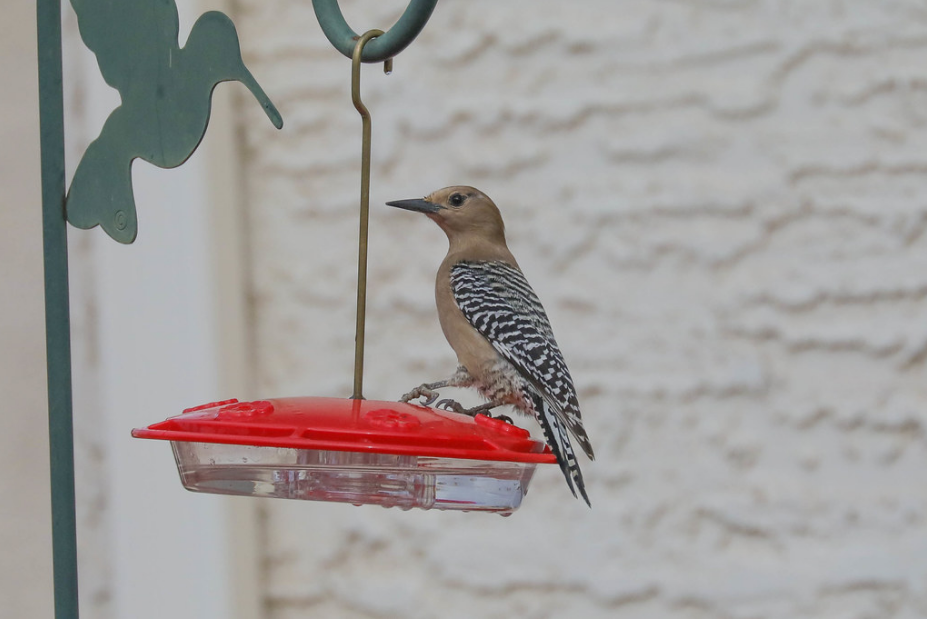
Conservation Status of the Gila Woodpecker
Gila Woodpeckers are designated as ‘low concern,’ and Partners in Flight estimates a breeding population of 1.5 million. While the Gila Woodpecker has declined in population in California, its population remains steady in Arizona.
Threats to Gila Woodpecker Conservation
Despite the Gila Woodpecker’s low concern status, threats to its long-term conservation include both climate and human factors.
Climate factors that threaten the Gila Woodpecker are droughts, wildfires, and severe heat during the spring. Droughts and spring heat waves destroy necessary water and food resources and make survival nearly impossible for young chicks. And when wildfires happen repeatedly, they can cause irreversible damage to the habitat.
The European Starling, an invasive species, has been known to evict Gila Woodpeckers from their nest cavities. Over time, this may lead to habitat loss for the Gila Woodpecker.
Human activity affects Gila Woodpeckers, too. When mature Saguaros, Palo Verdes, Cottonwoods, or other large trees are removed for clearings or construction developments, the Gila Woodpeckers lose their nesting and feeding sites.
How to Help the Gila Woodpecker
Setting up bird feeders in your yard supports the Gila Woodpecker’s life cycle. Some Gila Woodpeckers will perch and feed on hummingbird feeders, while others like corn, nuts, and suet. As omnivores, they eat insects, lizards, ants, and worms. Instead of using harmful pesticides, encourage Gila Woodpeckers to come to your yard so they can do the work for you!
Where possible, plant native cacti and trees – especially those with trunks or branches – which allow for nesting sites. If you are able, prevent or avoid the destruction of natural habitat. This means sticking to designated trails while hiking, respecting vegetation by keeping it free from trash, and preserving natural landscapes in favor of installing artificial ones.
Gila Woodpeckers, like all backyard birds, are susceptible to window strikes, which can permanently impair or kill a bird. You can prevent these collisions by installing decals, screens, stained glass, or other low-reflective products on your windows.
Similar Species
With 23 woodpecker species in North America, it can be difficult to distinguish between species. The Gila Woodpecker is distinct in its own right, but has some similarities, especially with these woodpeckers below.
Gilded Flicker
The Gilded Flicker shares the same range as the Gila Woodpecker. Its head is a dusty-tan-gray, similar to the Gila Woodpecker, but its body markings are quite different. Instead of a solid color body, the Gilded Flicker has a black neckband and black and white polka-dot pattern on its chest.
The Gilded Flicker’s outer wings are brown with black jagged bars, unlike the Gila Woodpecker’s zebra print. Instead of a red cap on the top of its head, the male Gilded Flicker has a patch of red on its cheeks – kind of like smudged lipstick. In flight, the Gilded Flicker’s wings fan open, creating a beautiful gilded look.
Just like the Gila Woodpecker, Gilded Flickers forage by pecking – and they have their evolutionarily-designed long tongue to thank for that. Unlike the Gila Woodpecker, however, the Gilded Flicker forages mostly on the ground, feasting on ant colonies.
The Gilded Flicker’s boot cavities are also susceptible to those bully European Starlings, but the Gilded Flicker does a better job than the Gila Woodpecker in standing up to them. Interestingly, European Starlings don’t threaten Gilded Flickers’ nesting sites.
Red-bellied Woodpecker
At a quick glance, the Red-bellied Woodpecker looks like the punk-rock twin of the Gila Woodpecker. Nearly identical, the only thing different in appearance is the red cap. Instead of a small patch, like on the Gila Woodpecker, the Red-bellied Woodpecker’s red spot is more like a mane – and it is on both sexes. Some red markings appear down on their face – as if they got a bit overzealous with the scarlet hair dye.
And before you get your feathers in a ruffle about the fact that the Red-bellied Woodpecker obviously isn’t red-bellied – and that it should be called Red-headed Woodpecker instead – but wait – that’s a whole other woodpecker species – here’s a cool fact. The Red-bellied Woodpecker got its name from the swath of light pinkish-red that can only be seen when the bird is hanging upside down.
Red-bellied Woodpeckers have migrated their way to the northeastern regions of the United States. Instead of soaking up the sun-caked desert (more like being really, really thirsty) like their Gila Woodpecker relative, Red-bellied Woodpeckers have found a home in deciduous forests and wet lowlands. Their population is abundant – around 16 million – and are considered stable.
FAQs
Answer: Gila Woodpeckers have adapted to perching on hummingbird feeders and drinking its surgery water. Corn, nuts (including pecans), and suet also attract Gila Woodpeckers. They may also be enticed by bird baths, fountains, ponds, and pet water dishes.
Answer: Flickers are woodpeckers. The Flicker is part of the order Piciformes and the family Picidae, which is the same for woodpeckers.
There are 23 native woodpecker species in North America. Some are called Woodpeckers, some are called Flickers, and some are called Sapsuckers. Think of it as an extended family with several different last names. Everyone’s related – and sometimes behavior and appearance are bizarrely alike – yet not everyone’s name is the same.
Answer: Yes! Although most common in southern Arizona, Gila Woodpeckers are spread throughout the lower southwestern United States and northern Mexico.
Answer: A Gila Woodpecker’s call is a sharp, one-syllable, chimp repeated five or six times in a row. It may vary in pitch and length. The Gila Woodpecker does not have a repertoire of calls or songs. Like other woodpeckers, it uses its bill to drum on resonant surfaces.
References
AZGFD. (n.d.). Arizona Game & Fish. Retrieved June 29, 2022, from https://www.azgfd.com/wildlife/livingwith/woodpeckers/#:%7E:text=Laws%20and%20Policies,by%20state%20and%20federal%20laws.
Bittel, J. (2017, January 4). This Woodpecker Will Drill Into Your Skull And Eat Your Brains—If You’re a Baby Dove. Smithsonian Magazine. Retrieved June 29, 2022, from https://www.smithsonianmag.com/science-nature/these-woodpeckers-will-drill-your-skull-and-eat-your-brains-if-youre-baby-dove-180961656/
Gila Woodpecker Overview, All About Birds, Cornell Lab of Ornithology. (n.d.). All About Birds. Retrieved June 29, 2022, from https://www.allaboutbirds.org/guide/Gila_Woodpecker/
Gila Woodpecker Fact Sheet. (n.d.). Arizona-Sonora Desert Museum. Retrieved June 29, 2022, from https://www.desertmuseum.org/kids/oz/long-fact-sheets/Gila%20Woodpecker.php
Gila Woodpecker. (2021, October 20). National Audubon Society. Retrieved June 29, 2022, from https://www.audubon.org/field-guide/bird/gila-woodpecker
Lowe, J. (2021, June 16). Woodpecker Species of the United States: A Photo List of All Native Species. American Bird Conservancy. Retrieved June 29, 2022, from https://abcbirds.org/blog20/woodpecker-species-united-states/
Looking for more interesting readings? Check out:


